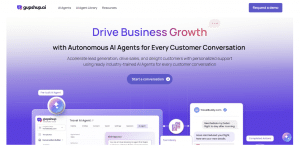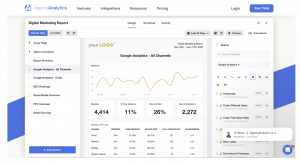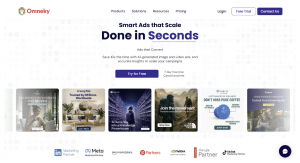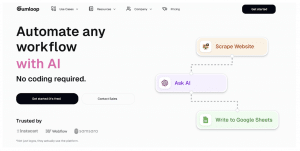Client expectations are getting sky high. And that’s partly because AI is now in everyone’s arsenal, including your clients’, so they expect agencies to add way more value (that they can’t extract themselves from AI tools, or simply don’t have the time), and way faster.
Put simply, fast replies, detailed reports, polished follow-ups—they all want more, and they all want it now.
And let’s not forget just how fast AI tech is moving.
For instance, tools like ChatGPT have redefined how teams handle day-to-day content and communication, from writing reports and drafting emails to brainstorming campaign ideas in real time.
Then there are specialized AI capabilities with tools like AI voice cloning, which have opened up new ways to personalize at scale, allowing agencies to create hyper-realistic audio messages or branded voiceovers using the actual voice of a founder, spokesperson, or client. Imagine sending custom client updates, onboarding walkthroughs, or multilingual support messages in a voice that feels familiar and on-brand.
Not to mention agentic AI assistants capable of holding multi-turn conversations, remembering client preferences, and even booking meetings or escalating issues—freeing up real human time for higher-value work.
So, the possibilities and capabilities with AI are endless. The problem? Agencies are already stretched thin. Scaling client-facing work without burning out your team is tough.
Fortunately, there are AI tools built for agencies to handle real agency pain points—client chats, reporting, meetings, ad creatives, and task workflows.
This post breaks down five standout AI tools, each built to handle a different piece of your client-facing puzzle. Whether you’re a two-person team or a full-scale agency, these tools can help you work faster, look sharper, and keep clients happier.
1. Client Communication & Support (Tool: Gupshup)

Let’s start with the most obvious client touchpoint: conversations.
Whether it’s new leads pinging you on WhatsApp or long-time clients asking for updates over email, staying responsive across channels is a grind. And doing personalized, on-brand, and 24/7 is pretty much a full-time job in itself.
Gupshup takes that off your plate.
It’s a conversational AI platform that helps you build smart bots across SMS, WhatsApp, web chat, and more (without needing to write a line of code!). You can train it to answer FAQs, qualify leads, book meetings, and even escalate to a human when needed.
You can spin up branded bots for each of your clients. That means automated, white-labeled conversations that still feel personal.
Its highlights include:
- Works across 30+ channels (including the ones your clients actually use)
- Pre-built templates for lead gen, support, feedback, etc.
- Easy handoff to human agents when needed
- Multilingual support (huge if you’ve got global clients)
Let’s say you’re running paid campaigns for a client and generating traffic to a landing page. Gupshup can engage those leads instantly, answer basic questions, book a meeting, and notify your team, all without you lifting a finger.
2. Client Reporting & Dashboards (Tool: AgencyAnalytics)

Prove this wrong: Reporting is one of the most time-sucking, soul-draining parts of agency life.
You’re pulling data from ten different platforms, formatting it, adding commentary, fixing broken widgets…all so your client can skim it for 10 seconds and ask if impressions are “good.”
AgencyAnalytics fixes that.
It pulls in data from 75+ tools—Google Ads, Meta, HubSpot, you name it—and builds sleek, automated reports you can schedule straight to your client’s inbox. Dashboards are drag-and-drop, white-labeled, and fully customizable.
Say, when you’re making expense reports for your retainer clients, the first thing that you’d do would be to rely on an expense report template. The same applies to monthly SEO reports, social media campaign performance reports, and what have you. These are repetitive tasks, and AgencyAnalytics saves you hours every week by automating all of them.
So instead of spending Friday night building a deck, you can actually wrap up early. Or, you know, do anything else.
Its highlights include:
- Pre-built templates for SEO, PPC, social, email, and more
- Automated email reporting (weekly, monthly, you decide)
- Real-time dashboards with custom branding
- Integrates with most of the marketing stack
Say you manage SEO and Google Ads for a client. You can create a live dashboard that updates daily, includes both organic and paid KPIs, and sends them a short summary report every Monday. That means fewer “Hey, where’s the report?” emails. And more time actually improving results.
3. Meeting Summaries & Follow-ups (Tool: Fathom)

Remember the last time a 30-minute client call turned into an hour? Then, someone drops a “Can you just send a quick summary after?” And just like that, you’ve got another task on your plate.
Fathom takes care of all that.
It’s like having an AI note-taker that actually gets what matters. It records your Zoom, Google Meet, or Microsoft Teams calls, pulls out the key highlights, and auto-generates a summary with timestamps, action items, and follow-up suggestions.
It’s clean. It’s accurate. And best of all? It’s instant.
Its highlights include:
- Real-time call transcription and smart summaries
- Automatically identifies key moments and to-dos
- One-click sharing with your team or clients
- CRM and calendar integrations to keep everything in sync
Say, you’re juggling five client calls in a day. Instead of scrambling to remember what each one wanted, Fathom gives you a smart recap with the next steps. Nothing falls through the cracks. No more manual notes. No more “Sorry, what did we agree on again?” (which can be embarrassing).
4. Campaign Creation & Creative Automation (Tool: Omneky)

Creating ads at scale is brutal. You’ve got to write copy, design assets, A/B test everything…and then repeat it for every platform. Multiply that across multiple clients, and suddenly your creative team is drowning in despair.
Omneky makes that headache go away.
It uses AI to generate ad creatives—text, images, layouts—based on performance data. It learns what works and then builds new variations to keep testing and improving. Think of it like a creative director that doesn’t sleep.
You still control the brand voice and visual style. But now, instead of starting from scratch every time, you’re editing smart suggestions that already fit the brief.
Its highlights include:
- AI-generated image + text ads tailored to each platform
- Built-in A/B testing and performance tracking
- Easy branding controls (colors, fonts, tone, etc.)
- Works across Facebook, Instagram, Google Ads, and more
Imagine you’re running a multi-platform campaign for a client’s product launch. Instead of manually creating 20 versions of the same ad, Omneky auto-generates the variants, tests them in real time, and shows you what’s converting best.
5. Workflow Automation (Tool: Gumloop)

So you’ve got your chatbot answering leads. Reports are automated. Meetings are summarized. Great. But how do you tie all that together without someone playing air traffic controller?
Gumloop is your answer.
It’s like Zapier meets ChatGPT, but less clunky and way more flexible. You can type in natural language prompts like “Send weekly SEO report to the client and log it in the CRM,” and Gumloop builds the automation for you.
No complex setup. No messy drag-and-drop flows. Just tell it what you want, and it handles the glue work between tools.
Its highlights include:
- Natural language automation builder
- Integrates with CRMs, calendars, email, Slack, Notion (you name it)
- Great for task chaining and approvals
- Built-in memory and context handling for smarter actions
Picture this: A new lead books a meeting. Gumloop logs it in the CRM, sends a pre-read doc, pings the team on Slack, and schedules a reminder in your calendar. All with one prompt. That’s hours saved every single week.
Wrapping Up
If 2023-2025 was about trying AI, 2026 is about trusting it. We’re entering the age of agentic AI, where your tools don’t just respond to prompts, they run full processes for you.
You’ll start seeing native integrations that feel seamless. Think: your reporting tool knows when a client meeting just happened and auto-updates your next presentation.
For now, start with one of these tools. Test it. See what sticks. Because in 2026, the agencies winning client trust will have AI by their side to its fullest potential.
Last Updated on August 6, 2025 by Ash